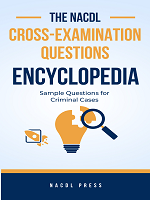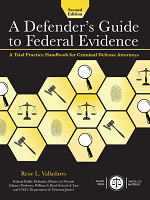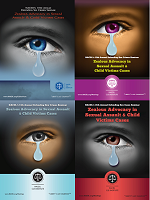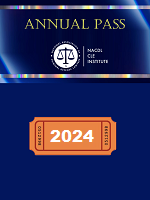Access to The Champion archive is one of many exclusive member benefits. It’s normally restricted to just NACDL members. However, this content, and others like it, is available to everyone in order to educate the public on why criminal justice reform is a necessity.
Little more than a decade ago, during the 2000 presidential election, an image emblematic of electoral defects pervaded American households: a half-punched ballot — a hanging chad, as it were — examined under the steady hand and unblinking eye of a Florida election official. The scrutinizing eye, made bulbous behind a magnifying glass — certainly cartoonish if not for its implications — ignited the debate on election reform.
Again, during the 2012 presidential election, as many states introduced new voting laws in response to alleged voter fraud, the election reform debate resurfaced. The right to vote is a fragile one, easily crippled by laws that disenfranchise while purporting to uphold the integrity of the electoral process. Without strong evidence of voter fraud, such laws are unwarranted, premature, and undermine the right to vote by alienating specific segments of eligible voters, primarily African Americans.
Since 2011, seven states have enacted photo identification laws, with more than 30 states introducing such measures.1 While many state voting laws include new registration requirements and voter-roll purges, the requirements for government-issued photo ID are most troubling because they are most baseless. States such as Indiana and Mississippi claim that such laws will combat voter fraud and improve the security and integrity of elections. However, evidence of more than minute incidents of voter fraud is simply unsubstantiated.
In the three-year span from 2002 to 2005, only 26 individuals were convicted of voter fraud; however, not a single conviction involved voter impersonation, which is the type of crime new ID laws were purportedly implemented to prevent.2 Of the frauds perpetrated, voting by ineligible individuals was the most common, although not pervasive. An accurate, centralized federal voter database, rather than photo ID requirements, would be better suited to resolve such an issue. The fact that many state legislatures vigorously address voter impersonation fraud while virtually ignoring voting by ineligibles, the most common of an excessively rare type of voter fraud, casts suspicion on the laws’ intent.
A more legitimate, and pressing, concern is the inaccuracy of many states’ voter databases, which are not updated and contain erroneous and duplicate registrations. Deceased individuals and those who have moved from one state to another may still be registered as voters in a state database that has not been updated. Such inaccuracies should be examined so as to avoid overzealous responses, specifically voter roll purges, which empower states to remove eligible registered voters from voter lists. Voter purges, which rely on state records, may disenfranchise eligible voters given that state records may not be current. In the event of outdated records, eligible immigrant voters are particularly vulnerable because their citizenship status may not have been updated. Illegitimate voter purges conjoined with voter ID laws threaten the right to vote.
Electoral reform laws that include ID requirements implicitly undermine the constitutional right to vote cemented in Amendments 15, 19, and 24 of the U.S. Constitution, which proscribe disenfranchisement on the basis of race, sex, and inability to pay voting-related taxes, respectively. At least 11 percent of eligible voters do not possess government ID, and this number is more than double among African Americans.3 State laws that require birth certificates at the voting booth, in lieu of government ID, disenfranchise women; less than half of eligible women voters have a birth certificate with their legal name.4 Identification requirements, in some instances, mirror Jim Crow era obstructions such as literacy tests, poll taxes, and discriminatory registration practices because they erect obstacles without legitimate reasons. Furthermore, election reform laws recently imposed by states beg further scrutiny, given that most of them were not enacted until after the 2008 presidential election, in which African Americans voted in unprecedented numbers, and overwhelmingly for President Obama.
While voter ID laws may appear innocuous, even necessary, further examination is warranted. These laws primarily impact African Americans. However, being overbroad, such laws also have the ability to exact damages beyond the African American community and target the elderly, the young, and the poor of all ethnicities. In many poor communities, access to a DMV is difficult because of sparse locations and limited hours. Additionally, costs associated with procuring government ID operate in a manner not unlike poll taxes and restrict otherwise eligible voters.
Even states that offer some limited alternatives to government-issued ID risk perpetuating a cycle of disenfranchisement. Consider an unemployed or homeless individual, or a high school senior who has yet to obtain a driver’s license or secure employment: these individuals would be restricted from voting by certain state laws that are more restrictive than federal law, which requires identification to register to vote, but not necessarily photo identification such as a driver’s license. The submission of a voter registration card upon voting should be sufficient.
Proponents of election reform laws have yet to present a legitimate basis for these laws and substantiate claims of pervasive voter fraud, but would deny citizens the right to vote by authority of mere speculation. The right to vote, or any fundamental right, must be exercised without unnecessary restraint. States should, and can, avail themselves of less restrictive measures to address potential voter fraud, including providing a paper trail for electronic ballots in the event of a recount and adopting a federal centralized voter database that would purge duplicate and ineligible registrations and be continuously updated. Additionally, to promote fairness and inclusiveness, the federal government should institute a uniform voter registration and voting process, rather than relying on states’ varying guidelines.
Recent incidents regarding the integrity of election results have not implicated voter impersonation fraud — which is the only conceivably legitimate purpose for voter IDs — but have uncovered problems with tabulation (recount of Florida votes during the 2000 presidential election) and electronic voting machine malfunctions (voting machines in Pennsylvania programmed to vote for Mitt Romney, regardless of voter intent, during the 2012 presidential election). If election reform is needed, it should address issues that impact fair election results that have been documented as problematic.
In the 2008 presidential election, 36 percent of eligible voters abstained from the polls, according to the U.S. Census Bureau. Thus, federal and state governments should focus on making voting more accessible rather than creating laws that not only make voting less inclusive but fail to address any legitimate voting concern. As such, they threaten to resurrect injustices outlawed by the Constitution and the Voting Rights Act of 1965. Until states can present unequivocal evidence of a problem concerning voter fraud, laws instituting new registration and ID requirements and voter-roll purges are premature and should be repealed. The populace must continue to regard such laws with suspicion when states seek to reform that which is not broken and encroach upon a most organic right.
Notes
- Brennan Center for Justice, Election 2012: Voting Laws Roundup, Oct. 16, 2012, available at http://www.brennancenter.org/content/resource/2012_summary_of_voting_law_changes/#_edn1.
- L. Minnite, Expert Report of Lorraine C. Minnite (2012), available at http://www.aclupa.org/downloads/Minnite.pdf.
- L. Norden & W. Weiser, Brennan Center for Justice, Voting Law Changes in 2012 (2011).
- Brennan Center for Justice, Citizens Without Proof: A Survey of Americans’ Possession of Documentary Proof of Citizenship and Photo Identification (Nov. 2006), available at http://www.brennanceSnter.org/page/-/d/download_file_39242.pdf.






